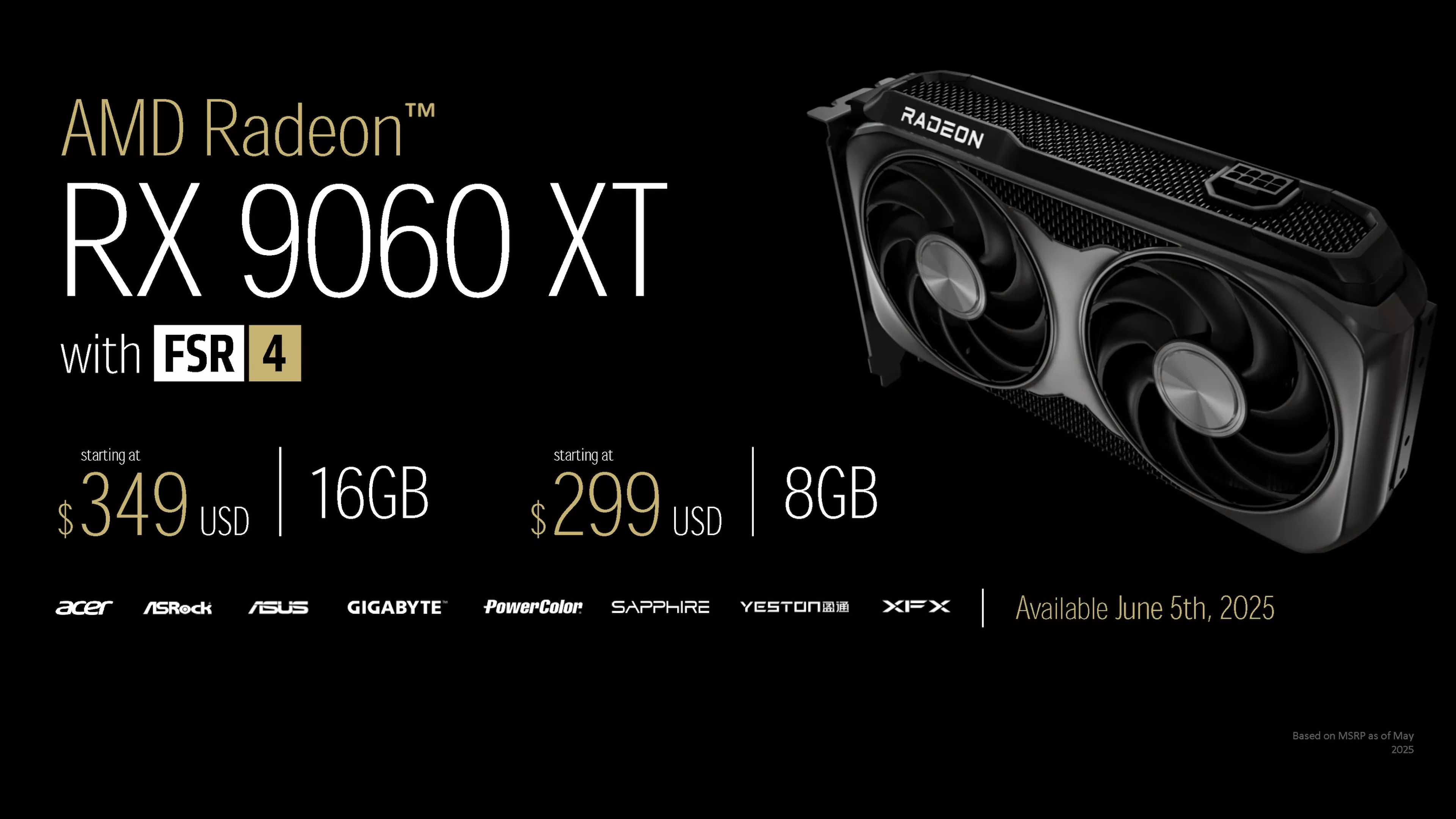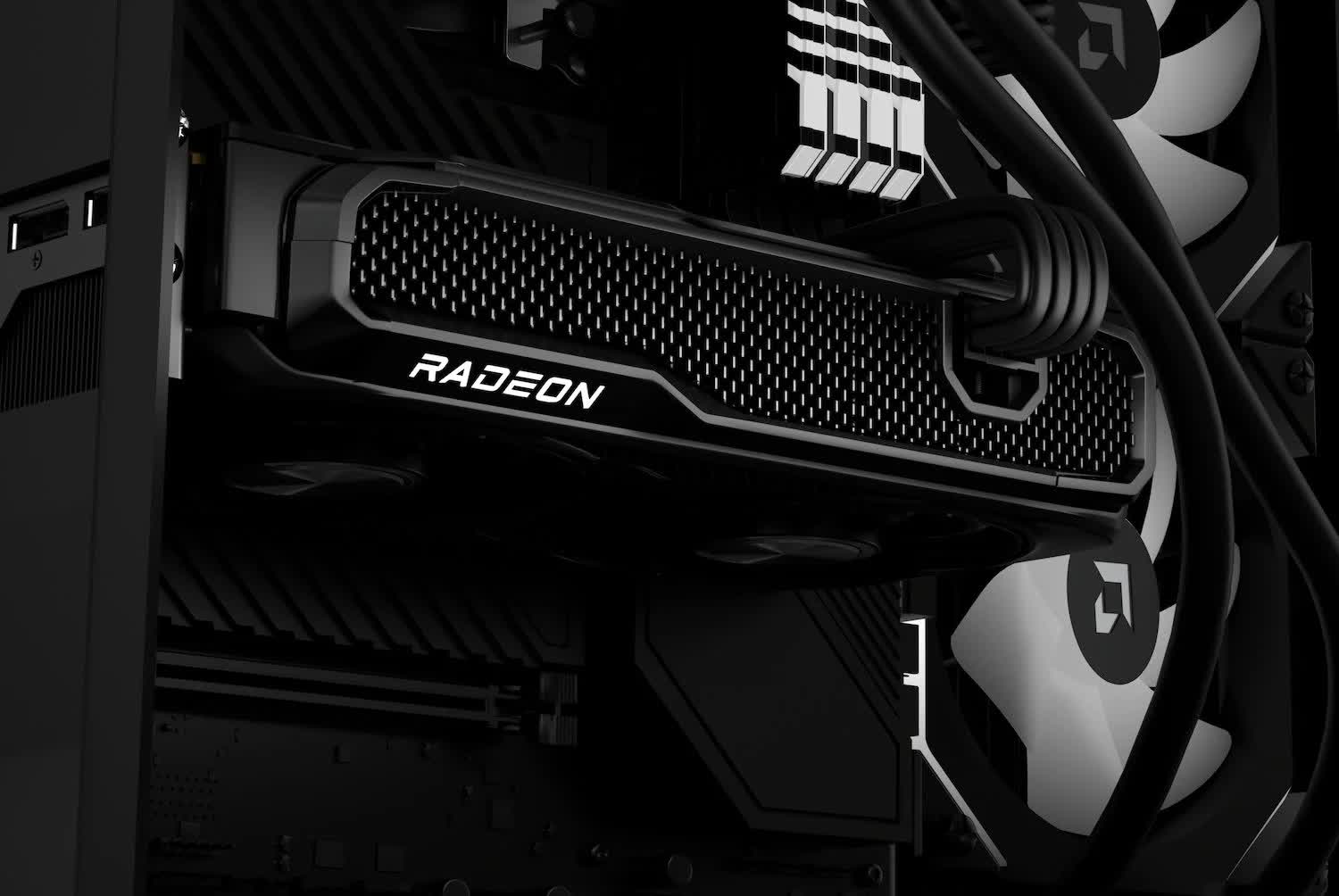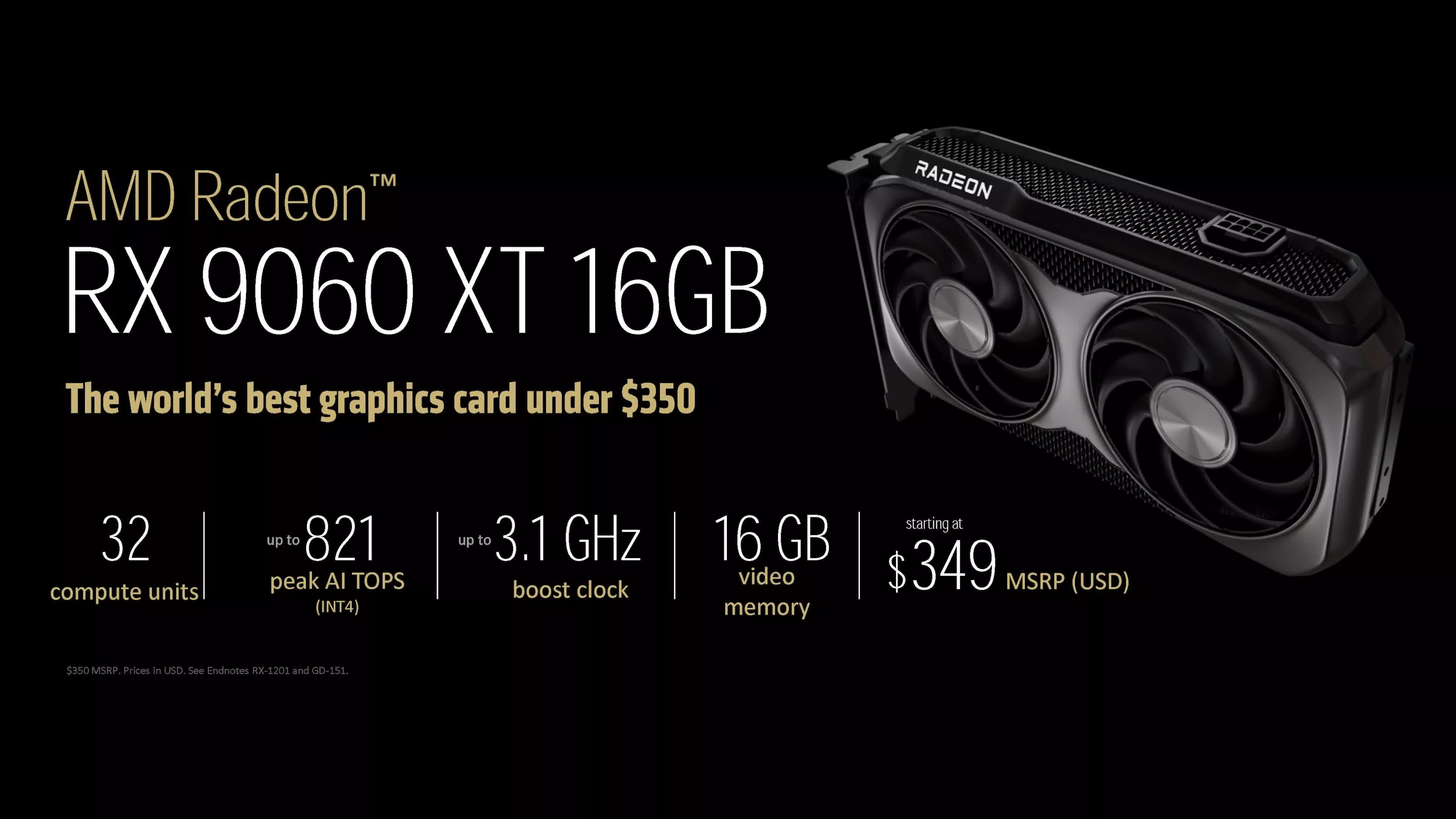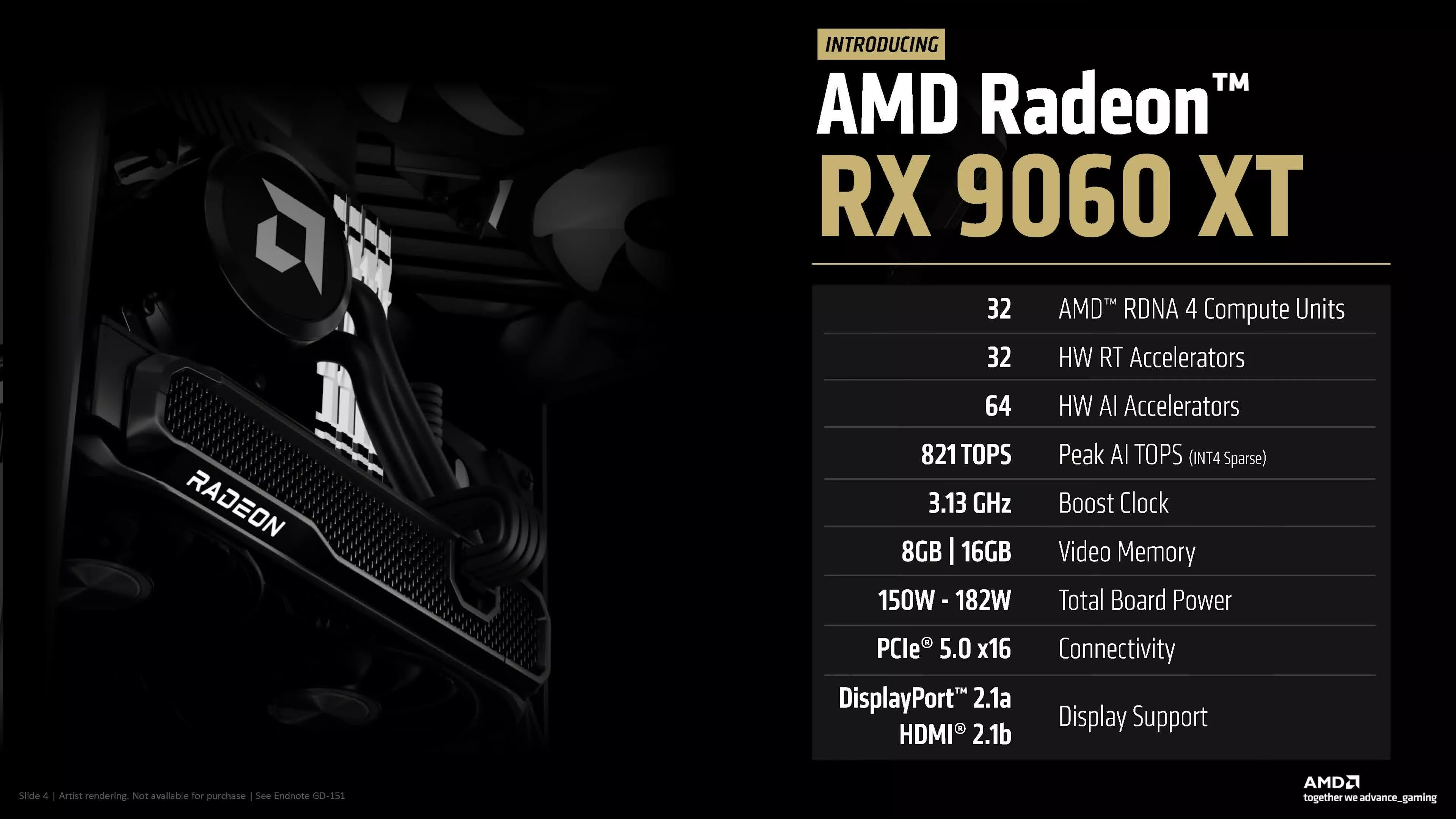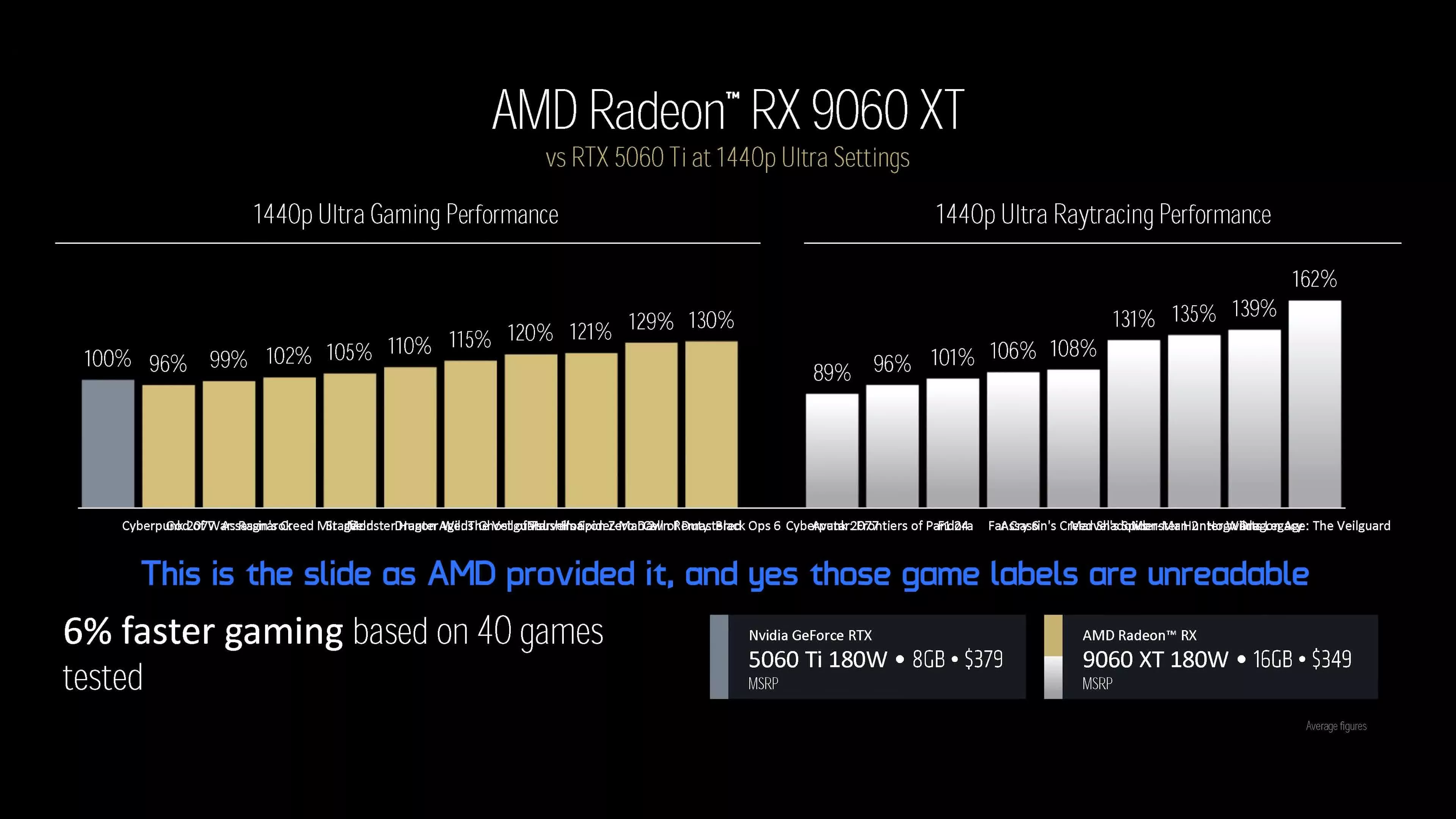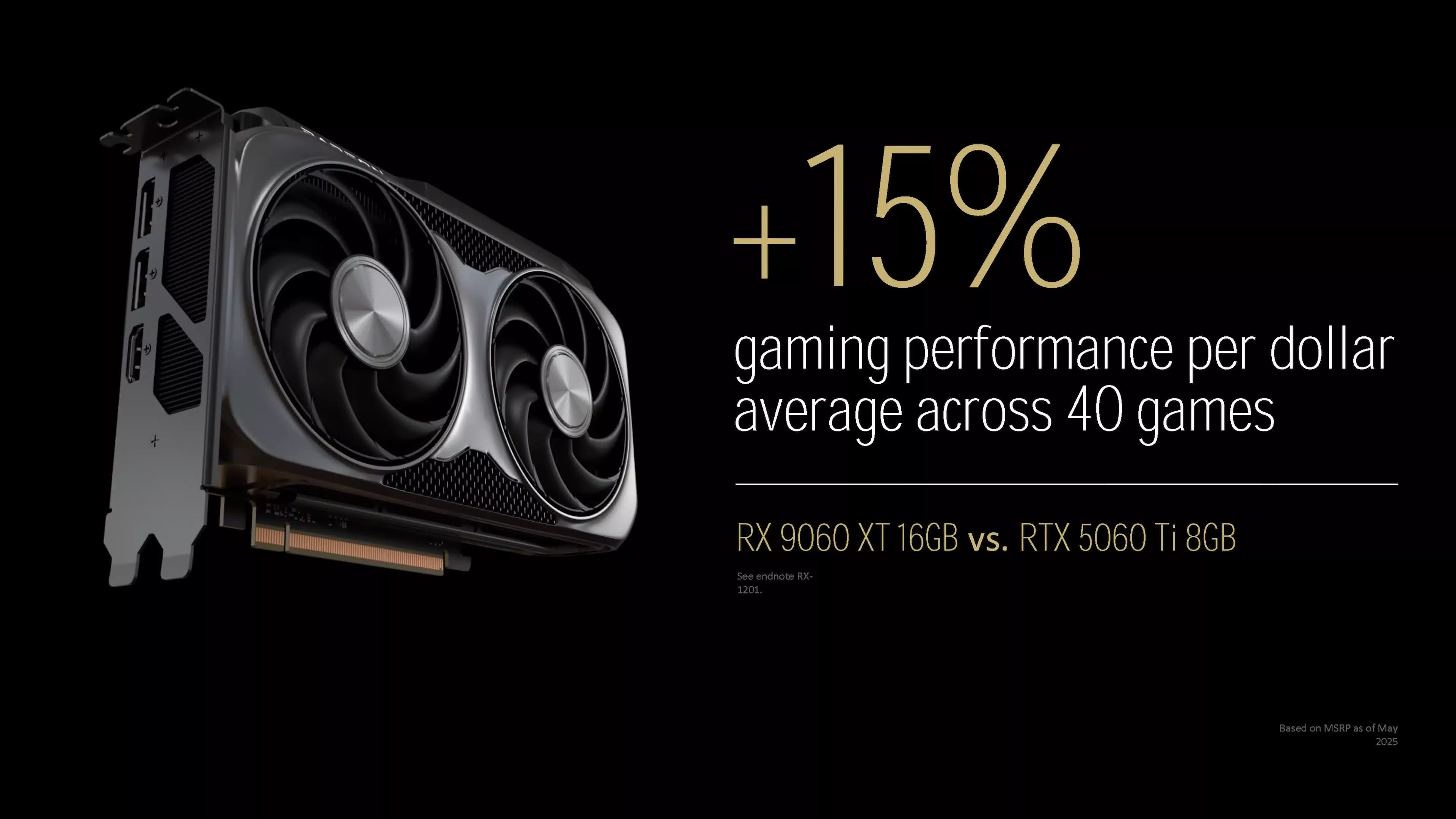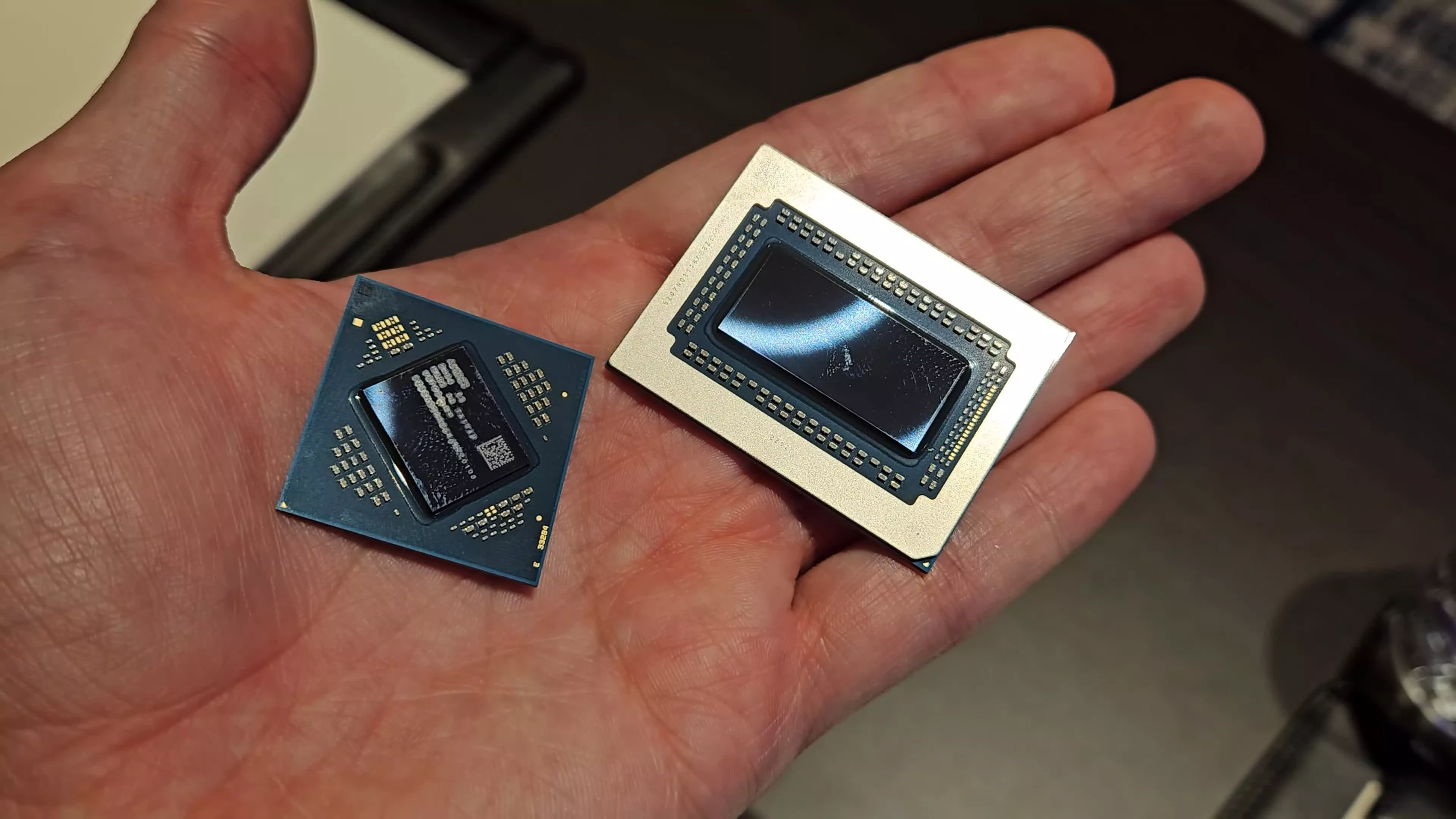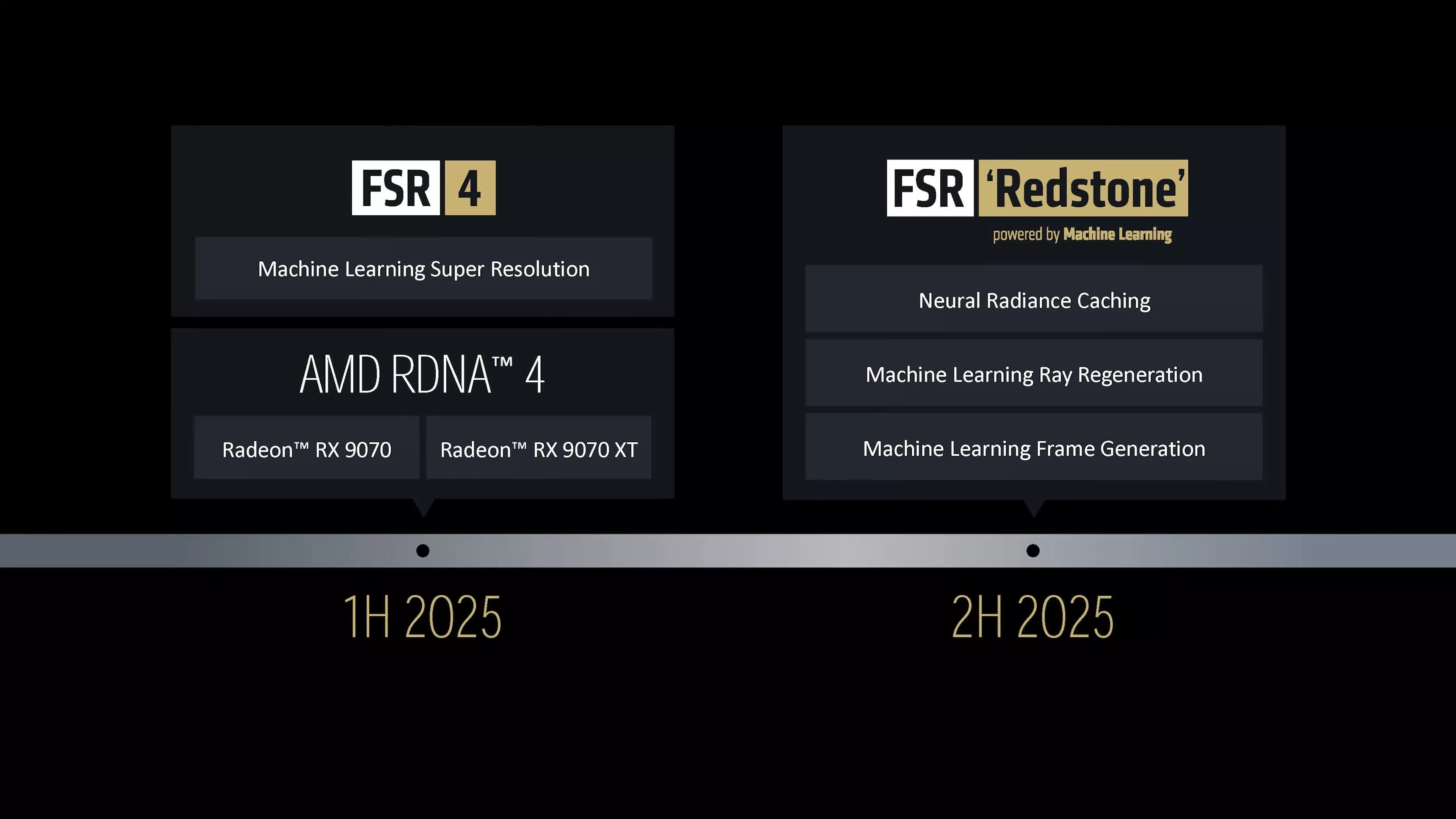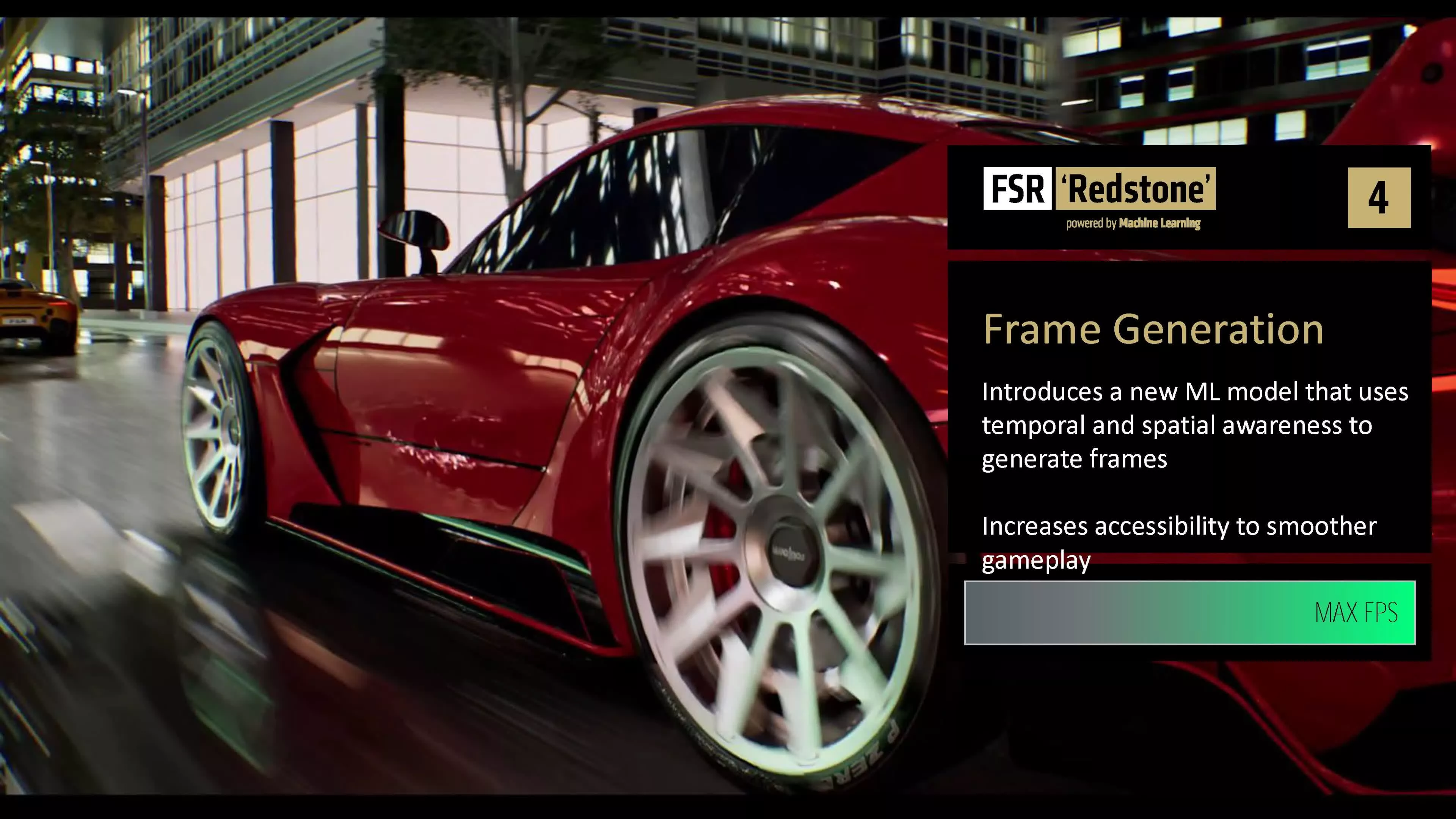Editor's take: AMD has unveiled the Radeon RX 9060 XT, which comes in a bad version and a good version. The bad version is, of course, the 8GB model, and the good version – or potentially good, depending on how it performs – is the 16GB model. AMD has copied Nvidia's RTX 5060 Ti homework here, giving both models the same name, which is sure to make it more difficult for consumers to find the good version.
The Radeon RX 9060 XT will become available on June 5, priced at $300 for the 8GB model and $350 for the 16GB graphics card. AMD's main focus during its presentation was on the 16GB variant, which they're claiming will be the dominant, more widespread card in western markets, and with this pricing, it will be the cheapest current-generation 16GB graphics card.
Essentially, the RX 9060 XT is half of the RX 9070 XT. It uses a brand-new Navi 44 die, which has half the core and memory configuration of Navi 48 at nearly half the die size – it's ended up at 199 sq mm. Instead of receiving 4096 shader units in 64 SMs, Navi 44 provides 2048 shader units in 32 SMs. The memory bus has also been slashed from 256-bit to 128-bit, though 20 Gbps GDDR6 is still being utilized here. This results in 320 GB/s of memory bandwidth – again, half that of the flagship RDNA4 model.
AMD has not provided game clock information for this GPU yet, but the boost clock is listed at 3.13 GHz, which is a little higher than the 9070 XT's 2.97 GHz. We're also getting a PCIe 5.0 x16 interface – not x8, which is good news for those with older PCIe 4.0 or 3.0 motherboards – along with DisplayPort 2.1 UHBR13.5 and HDMI 2.1. The 9060 XT has one less display output than the Navi 48 models, with one HDMI and two DisplayPorts.
Total board power is listed as a range of 150 to 182 watts. This is due to the 16GB model having more memory chips and higher overall board power. However, we've been told the GPU itself is identical regardless of which memory configuration you get – same GPU power, same core configuration, and clock speeds.
So again, essentially this card is roughly half that of the RX 9070 XT, especially for the 8GB model, which also halves the memory capacity.
With half the hardware, it makes sense to expect the RX 9060 XT to deliver around half the performance of the RX 9070 XT. AMD is claiming the 9060 XT 16GB will be around 6% faster than the RTX 5060 Ti 8GB on average across a 40-game sample tested at 1440p using ultra settings.
Now, you might notice they are comparing their 16GB model against Nvidia's 8GB model – that's because they are the closest in price. I asked AMD about whether that would also be true comparing 16GB vs 16GB, and they said we should expect both the 9060 XT and 5060 Ti to offer similar performance.
Based on our testing of other models, this would make the 9060 XT about 35 to 40% slower than a 9070 XT – so a little better than half the performance from half the die size – and similar performance to a Radeon RX 7700 XT from the previous generation.
When running some calculations based on AMD's claims – which, of course, you should take with a grain of salt – the 9060 XT should offer over 20% better value than the RTX 5060 Ti 16GB: similar performance, but with the MSRP cut from $430 to $350.
When running some calculations based on AMD's claims – which, of course, you should take with a grain of salt – the 9060 XT should offer over 20% better value than the RTX 5060 Ti 16GB: similar performance, but with the MSRP cut from $430 to $350. Of course, this is assuming both the AMD and Nvidia cards will be available at those prices, something that isn't typically the case these days, especially in the United States. It should also mean around 15% better value than the RTX 5060 Ti 8GB, but with the added benefit of a more suitable 16GB memory capacity.
The 8GB card at $300 should offer around 20% better value than the RTX 5060 Ti 8GB as well, though this card will be much less appealing due to its limited VRAM at a high $300 price point.
Really, this card either shouldn't exist or should be priced below $200, which is probably unrealistic given the performance of the GPU itself. As we've said many times now, we strongly feel $300 graphics cards should have more than 8GB of memory in the year 2025. The saving grace here is that Nvidia is still selling an 8GB GPU for $380, which is even worse, while AMD's most expensive 8GB card will be $300.
With the RX 9060 XT positioned as it is, it has the potential to kill the entire RTX 5060 series. Along with claims of superior value compared to the 5060 Ti, it should be better value than the RTX 5060. For an extra $50, comparing MSRPs, the 16GB 9060 XT should offer double the VRAM and a higher performance tier.
We know the RTX 5060 performs around the level of a 4060 Ti 8GB, but the 9060 XT should be more like a 5060 Ti, which is 20% faster. Also available will be a card with the same VRAM and price as the 5060, but a tier higher in performance.
The other interesting comparison to make is to the Radeon 7700 XT. While this GPU launched at $450, it quickly dropped to around $400 and was available at that price at the end of 2024. Essentially, the RX 9060 XT is the successor to this model, offering similar raster performance, better ray tracing performance, access to FSR 4 upscaling, and an improvement from 12GB to 16GB of VRAM for a $100 lower MSRP and potentially $50 lower real pricing.
That doesn't sound amazing from a value standpoint, but the 9060 XT is looking like a clearly superior product. On the other hand, it's also an upgrade from the 7600 XT, which was priced at $330. For $20 more, AMD is claiming to offer the same VRAM, better features, and potentially upwards of 30% more performance.
Essentially, the RX 9060 XT is the successor to the 7700 XT, offering similar raster performance, better ray tracing performance, access to FSR 4 upscaling, and an improvement from 12GB to 16GB of VRAM for a $100 lower MSRP and potentially $50 lower real pricing.
While we're really liking the look of the 9060 XT and its $350 price point for a 16GB GPU, the 8GB card simply shouldn't have the same name – or at least a name that is very similar to the 16GB model. This is a huge issue we had with the RTX 5060 Ti, where the existence of a good model and a bad model with the same name made it easy for consumers to fall into a trap of purchasing the terrible 8GB model.
Often the 8GB card would come up first at retailers when searching for the 5060 Ti, and because it was the cheapest version, it would be the most enticing for gamers who weren't overly familiar with the differences between 8GB and 16GB. Those gamers would buy the 8GB card and be left with a model that's instantly obsolete.
The exact same issues will be present with the RX 9060 XT 16GB and 8GB models, and this could have been easily prevented if AMD simply called the 8GB model something else, like the "RX 9060" without the XT at the end. Now, maybe they are also planning to release an RX 9060 at some point, but there's plenty of numbers to use, and these two cards should be more distinct so gamers don't fall into a trap.
This is, of course, in addition to the fact that $300 for an 8GB card is too much to pay, but I won't go over all of that again.
On a more positive note, AMD made it very clear that they will not be trying to bury or manipulate RX 9060 XT reviews. With the launch date set at June 5th, reviewers will have access to 9060 XT drivers – for both the 8GB and 16GB models – early next week, giving a week and a half of pre-release access. Samples should also be ready very shortly, and there will be no restrictions on 8GB and 16GB sampling; both will be available to test before launch on request.
The focus will be on the 16GB graphics card they insist, but we recently saw a whole bunch of shenanigans from Nvidia relating to the 8GB RTX 5060 Ti and RTX 5060, including preventing 8GB 5060 Ti samples from reaching media pre-launch and not running a review program at all for the 5060. AMD is doing none of that with this launch.
FSR Redstone
The other main graphics-related announcement from AMD at Computex 2025 is FSR Redstone, the next evolution of FSR that is coming in the second half of 2025. This is a set of additional features coming to the FSR family, all of which are AI-based: there's neural radiance caching, ray regeneration – a.k.a. AMD's version of Nvidia's ray reconstruction – and an updated version of frame generation that uses AI to enhance image quality.
We got some still image examples of how these features will improve ray-traced gaming. We're expecting them to offer similar advantages to other technologies on the market today, but for Radeon GPU owners.
Provided these technologies work well, they should allow AMD to close the features gap with Nvidia, who rely on tech like ray reconstruction and AI-based frame generation for path-traced gaming.
Because the technology isn't expected until the second half of 2025, it's not clear how FSR Redstone will be integrated. With FSR 4 upscaling, right now it's a driver-based toggle that converts FSR 3.1 implementations into AI-based FSR 4.
This might also be possible with AI-based FSR frame generation based on what AMD was saying, but other features like neural radiance caching and ray regeneration might require game integration and additional APIs. So we'll see how that goes later in the year.
AMD also announced that FSR 4 game support will be expanding to 60 titles on June 5, alongside the launch of the RX 9060 XT, which is relatively good adoption given we saw around 30 titles supported at the launch of the 9070 XT.
The biggest weakness AMD has with FSR 4 isn't the quality of the technology itself – which is very good – but game support compared to Nvidia's DLSS 4 and DLSS 3. If AMD can continue this pace of FSR 4 title support, that will be great news for Radeon buyers.
